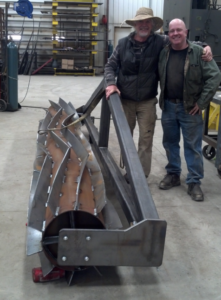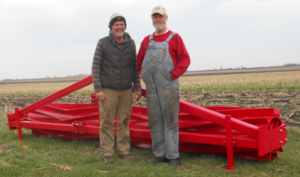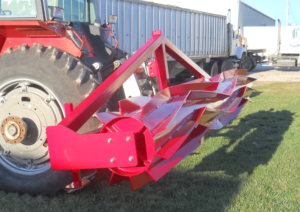2016 Annual Report for FNC16-1055
Developing Sustainable Roller Crimped Cover Cropping Systems for Corn and Soybean Production: Effects on Cover Crop Winter Hardiness, Biomass, N Mobilization, Weed Suppression and Yields
Summary
We had three main hypotheses for our project:
- 1) If cereal rye can develop enough biomass, then after-crimping weed pressure will be minimal in a no-till vs conventional till system before soybeans.
- 2) If a bio-soil enhancer can promote increased microbial activity, then N uptake will accelerate canopy formation, facilitate prolonged weed pressure control and improve pest resistance.
- 3) If a bio-soil enhancer can improve fall hairy vetch root formation, then winter hardiness will improve, along with subsequent after-crimping spring N mobilization before corn.
We broadcast the rye cover crop seed at 3bu/ac using a modified Hagie on September 15, 2015.
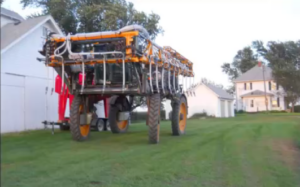
We documented growth daily for the first week and then bi-weekly on each partner’s field until it was crimped.
Mother nature provided 1.3″ of rain a few hours after broadcasting the seed.
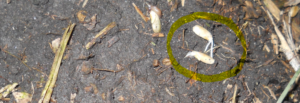
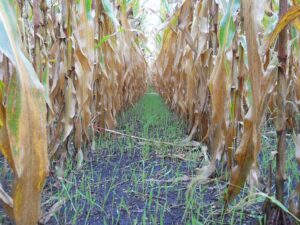
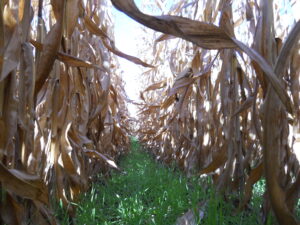 18 hours 4 days 7 days
18 hours 4 days 7 days
Here is the trial design of 8, 2.5ac plots on each farm with 4 replications of with or without the bio-soil enhancer:
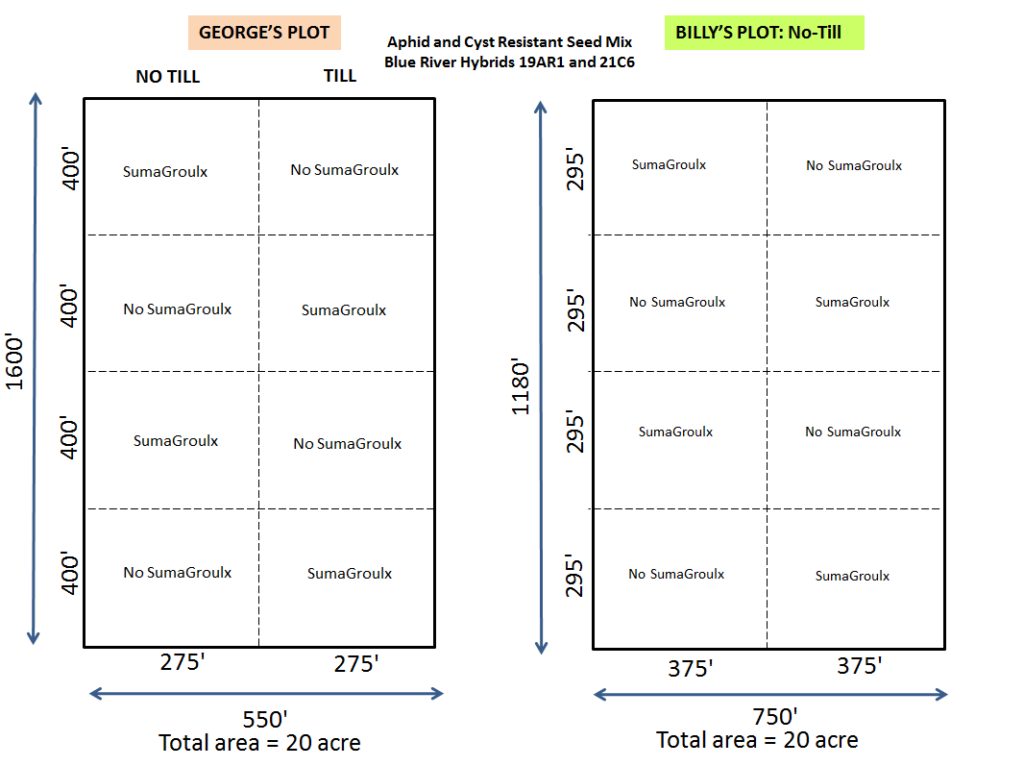
Roller Crimper Manufacturing: The roller crimper was designed after an I & J model and built by a local metals fabricator. A modified chevron design and thicker gauge steel was used to increase dry weight and down pressure. The result was a highly efficient 3-pt crimping tool:
We planted soybeans with 15″ row spacing into the standing rye on 5/20/2016 and then crimped immediately afterwards over the next two days. We crimped twice, once in each direction, to minimize re-growth. The rye height averaged over 4′ tall. Here is a quick peek at how it worked:
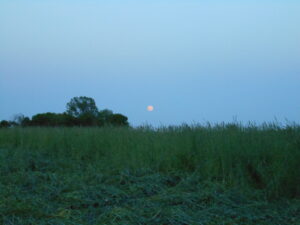
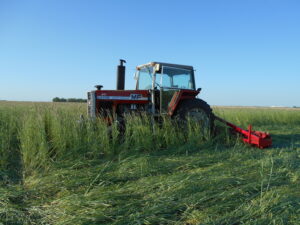
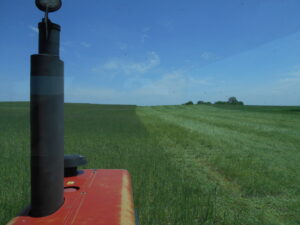
Data Collection and Analysis: A team of ISU graduate students, led by Dr. Ajay Nair, assistant professor in the Horticulture Dept. at Iowa State University, visited the fields on several different occasions to collect data about soil health and physical plant profiles. Analyses commenced at the ISU Vegetable Production Lab.
Objectives/Performance Targets
The tentative results thus far reveal that the plots which contained the bio-soil enhancer showed promise of producing higher yields, and healthier soil, but the results did not meet significant difference at the p. The growth of the soybeans mimicked the 8-years of observations and experiences of Dr. Erin Silva, a plant pathologist and assistant professor at the University of Wisconsin, Madison. That is, it is apparent that a good portion of the weed suppression effects occurs from the allelopathic mitigation of the crimped rye. There was suppression of nearly all annual weeds and there was a noticeable stall in normal growth of the soybeans.
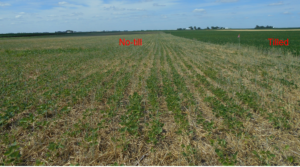
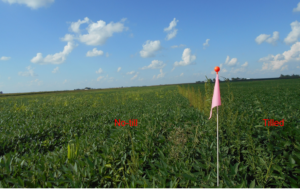
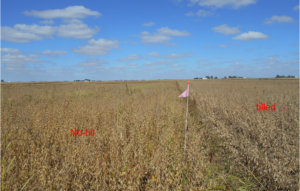
July 01, 2016 August 15, 2016 October 01, 2016
In the Partner’s tilled field comparison, the soybeans were growing normally, but so were the weeds. Within a month, the soybeans in the no-till field caught up to their tilled counterparts with continued excellent weed suppression. Yields were similar, tilled 56bu/ac vs no-till 52bu/ac, but mechanical, physical and NOP-compliant herbicidal weed control costs in the tilled field eliminated any initial yield benefits according to calculations using the Ag Decision Maker averages for labor, fuel, materials and equipment depreciation costs.
Accomplishments/Milestones
What we’ve learned so far:
- Cultivar selection…winter hardy AND early maturing. We crimped at the 25 – 50% anthesis rate due to incoming storms and the later maturing cultivar (Rymin). Using an earlier maturing cultivar (Aroostook or Elbon) and waiting until a higher rate of anthesis would lessen the need to crimp twice.
- Planting…drill vs broadcast. This depends upon harvest date. Broadcast provides better distribution of seed and cover when there is adequate moisture. Drilling provides better assurance of germination in drier conditions, but with gaps, which tend to offer enough light for weed growth.
- Biomass…retains moisture, provides adequate weed suppression and builds organic matter. Three – four bu/ac seems necessary to provide adequate biomass for weed suppression and prolonged allelopathic effects.
- Anthesis rate at crimping…the higher the level, the better initial termination. However, in comparison to some neighbors who crimped at a higher level of anthesis, yields and weed suppression effects did not differ.
Describe your work plan for next year:
We aerially applied a combination of oats and hairy vetch onto each of the soybean fields on 9/13/16. The bio-soil enhancer was ground applied on trial plots on 10/17/16. We want to see if the bio-soil enhancer helps the hairy vetch to over-winter and determine the extent to which N mobilization reduces the need for any additional fertilizer. Growth records and soil-health data collection will follow a similar protocol as in Year 1.
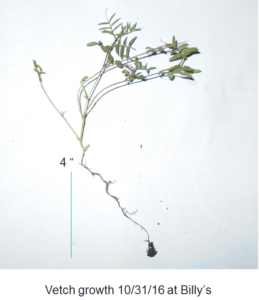
We aerially applied the Elbon rye cover crop seed onto the cornfields on 9/10/16. We will determine if an earlier maturing variety allows for earlier soybean planting and crimping of the rye afterward.
Impacts and Contributions/Outcomes
Outreach:
We held a Practical Farmers of Iowa (PFI) Field Day on 6/15/16 and over 120 people attended from six different States. Several articles have appeared on the PFI web site and one in the August, 2016 edition of the Wallaces Farmer magazine.
http://www.practicalfarmers.org/blog/2016/06/22/rolling-2016-field-day-season-churdan/
A presentation occurred at the annual Iowa Organic (IOA) conference on November 14 in a session with Dr. Kathleen Delate, Professor in the Horticulture Dept. at Iowa State University. There are invited presentations upcoming at the PFI annual conference in January, 2017 and in a University short course at the Midwest Organic and Sustainable Education Service (MOSES) annual conference in February, 2017. Local Natural Resources Conservation Service (NRCS) staff have been kept up-to-date with progress and visited the farms on several occasions. There are plans to present at the local Paton-Churdan School Science Fair next year. The Non-GMO Report plans to publish an article highlighting the project in late Spring, 2017.
Collaborators:
Conservationist
NRCS
1703 N Elm St
Jefferson, IA 50129
Office Phone: 515-386-3138
Assistant Professor
Iowa State University
Dept. of Horticulture, Rm 145, Iowa State University
Ames, IA 50011
Office Phone: 517-898-5349
Website: http://www.extension.iastate.edu/vegetablelab/search/content/ajaynair
Assistant Professor
University of Wisconsin, Madison
College of Agricultural and Life Sciences, Dept. of Plant Pathology, 683 Russell Laboratories, 1630 Linden Dr.
Madison, WI 53706
Office Phone: 608-890-1503
Website: http://www.uworganic.wisc.edu/about-us/primary-investigator/
